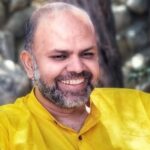Yogacharya Krishnamacharya’s expositions of the Yoga Shastras was always simple, profound and pragmatic. When giving a gist of the Shrimad Bhagavad Geeta he said that it comprised of four parts that form the essential stages for the management of personal crisis. These are: Acceptance, Breathing, Curiosity and Distance.
A for Awareness
When Arjuna turns to Shri Krishna and asks for help he states his condition with honesty and acuity. He states the bodily reactions, the emotional agitation and mental confusion accurately; He simply states his lack of conviction and feelings of inadequacy, he stands vulnerable and open. This according to Yogacharya is the starting point. Recognizing that one is duhka, and being able to look at it is difficult. We stand on prestige, on compulsions or are afraid to look at our selves. Without a simple and clear observation of one self as one is the way to become the best that one can be is blocked.
This is perfectly in line with modern research into “stress”. When one is stressed, the usual response is one of the three: fight, flight or freeze. Fight means one tries to over come the reality through compulsions- I must/ I should/ I must not/ I should not. This inner friction not only makes one loose energy, it increases the feelings of stress and inadequacy. Flight is simply a denial of what one is feeling. One therefore becomes blind to the reality, the danger that one is facing. Pretense takes over and often one escapes from facing reality and just lets the problem fester. Freeze is to become inarticulate and indecisive to the extent that one is just over whelmed by the situation. Flow is the way to end the dysfunctional response and flow starts with honest self-appraisal. The more one is in touch and self-observant, the more one will be able to sense the body and emotions as they respond to the signals of danger and opportunity.
To illustrate, negotiations are often very stressful. There is a situation of opportunity and threat; one has to deploy resources in ways that are optimal. If one is not self aware, one can get caught with Fight/ Flight or Freeze and the other person is given the advantage:
- Fight- ‘I must prove myself/ I should not feel stressed’: so one takes an aggressive stance, puts up the other persons back, while becoming increasingly brittle
- Flight- ‘I am afraid to feel the danger so I remain unaware of it’: so one stays cool, misses important cues and weakens ones negotiating position
- Freeze- ‘I hide my head in the sand, become non-responsive’: one goes through the motions of the discussion ritualistically and completely misses the point
- Flow- ‘ I am aware of the danger, but I am not afraid to feel the fear’: I can remain anchored in my self, face the challenge and make appropriate choices. May be I just reschedule the meeting for another time! Flow means to be in touch with ones gunas, ones propensities and not fight them
So, now we come to B for Breath.
When one senses danger/ stress many bodily changes take place, chemicals like Cortisol are produced, one is ‘bracing up’ for fight or flight. The first indicator of this internal change is the change in breath. If one is sensitive to the signals without succumbing to them, one is not only capable of acute observation of ones state, one can do some thing to prepare to face the situation. The first thing to do is to quite ones breath. We find this constant recommendation in Buddhist texts too.
Excessive stress chemicals makes ones focus narrow, ones memory is impaired, ones ability to access learning is reduced and one is on “auto pilot”, ones body becomes taught and ready for action and ones emotions are locked into sensing threat. If we were in the primitive days when immediate explosive action was called for in situations of danger, the fight/ flight response may have worked. Even there, the warrior who is calm and observant has a much better chance of acting rightly. Getting in touch with ones Breath immediately kicks off the process of balancing the inner chemical state. One can think appropriately, and remember lessons and preparation, one can feel and sense one self and the others persons reactions, ones body comes to a neutral state of readiness. Auto pilot means thought, feeling and action are locked into old habits that are completely out of touch with the here and now challenge.
What happens at the negotiation? The person whose breath is balanced and therefore whose pulse rate is lower, has the advantage; It as simple as that. Theatre personalities, athletes and public speakers know the importance of breath and how to be optimally ready.
That brings us to C for Curiosity
When we are honestly in touch with ourselves and have regained calm, we are ready to understand, to enquire into what is happening to me, what is the reality of the situation and therefore decide what is the right action. Yogacharya was clear that it is only after helping Arjuna do some Praanaayaama that the rest of the teaching started. One cannot listen, think and absorb anything in a state of tension. Arjuna is helped to reexamine the context, the larger consequences, his assumptions about man and the world.
To illustrate, our protagonist is encountering his/her first interview, and with every question his/her stress is mounting. Unless the A and the B of self management (described above) are internalized, the chances are that a vicious cycle will get established, soon all the symptoms that Arjuna recounted like the throat becoming dry, the muscles becoming tense, memory deserting our very bright student will start. The interviewers will become enemies, and odd conections will be made of innocuous signals. Let us say our protagonist is self aware, and regains calm, she can now look at the interview that was becoming a do or die situation as a learning situation, view the interviewers as people listen carefully, have a conversation that helps her assess herself and gain a first hand understanding of how interviews are conducted, and probably have a sense of the kind of organization it is. Chances are she will come though as friendly, open to learning and cooperative, and land the job. In any case she now has the choice of saying yes or no!!
One is now ready for D for Distance
Sankhya emphasizes the idea that unless one is at the right distance from an object of enquiry, one cannot understand it. A mind that is not stressed, and senses that are sharp among other conditions like having an unobstructed view and being able to distinguish the object clearly are also important.
The more one is able to be self-observant, balanced and calm the more one can be at this optimal distance, listen and learn. The alternative is to get consumed by the situation just get buffeted about and be none the wiser for the experience. The position one takes when one is curious, inquisitive and exploratory is already one of middle-distance from what is happening. One is not too close, nor too far away.
It is now possible to say “my identity is not defined by the situation, I am not my feelings or thoughts.” This detachment sets off a very positive cycle. Not only is learning possible, the simple open and vulnerable listening makes it possible for ones hidden potential and deeper insights to bubble up. The voice of ones meditative core, Shri Krishna’s voice can come through.
Modern research has not only confirmed the symptoms and consequences of stress that Arjun articulated, but also the immense opening up of capability and hidden power that comes from Dhyaana- mindfulness. Awareness, Breath, Curiosity and Distance create the ground for action that is mindful.

 Anoop is a student of Yoga, an entrepreneur, a coach and a father of two young boys. He has led successful leadership stints in both the corporate and non-for-profit sectors. On encountering the country’s water/farmer crises at close quarters, he decided to pause and examine the impact various ‘isms’ – capitalism, colonialism, etc., were having on us as individuals, families, the society and the environment at large. This quest led him to formally engage with traditional Indic knowledge systems while also learning from the latest advances in science – about our physical and mental wellbeing, importance of body and mind work in healing trauma and the urgent need for a conscious rebuilding of family / work / social structures if we have to thrive individually and collectively. Insights, frameworks and processes gleaned from these on-going studies, an anchorage in his own personal practice and his wide-ranging experiences is what Anoop brings to facilitation/coaching spaces in Ritambhara and his various professional engagements.
Anoop is a student of Yoga, an entrepreneur, a coach and a father of two young boys. He has led successful leadership stints in both the corporate and non-for-profit sectors. On encountering the country’s water/farmer crises at close quarters, he decided to pause and examine the impact various ‘isms’ – capitalism, colonialism, etc., were having on us as individuals, families, the society and the environment at large. This quest led him to formally engage with traditional Indic knowledge systems while also learning from the latest advances in science – about our physical and mental wellbeing, importance of body and mind work in healing trauma and the urgent need for a conscious rebuilding of family / work / social structures if we have to thrive individually and collectively. Insights, frameworks and processes gleaned from these on-going studies, an anchorage in his own personal practice and his wide-ranging experiences is what Anoop brings to facilitation/coaching spaces in Ritambhara and his various professional engagements.
 Priya is a Yoga therapist in the Krishnamacharya tradition. She adapts Reiki & energy work, Vedic chanting, life coaching & Ayurvedic practices in her healing spaces. She is committed to nurturing collectives that have the praxis of Yoga at their heart.
Priya is a Yoga therapist in the Krishnamacharya tradition. She adapts Reiki & energy work, Vedic chanting, life coaching & Ayurvedic practices in her healing spaces. She is committed to nurturing collectives that have the praxis of Yoga at their heart. Anisha has been on an exploration to understand herself through yoga for the last 15years which led her to teaching yoga, yoga therapy and inner work through yoga.
Anisha has been on an exploration to understand herself through yoga for the last 15years which led her to teaching yoga, yoga therapy and inner work through yoga. Apoorva chanced upon Yoga in her early 20s. A spark was lit within and there was no turning back. Her exploration led her to the Krishnamacharya tradition more than a decade ago. Curious about human behaviour and what drives it, she was thrilled when her search ended (and also began) when she first came upon the Yoga Sutra, which illuminated a path towards answering many questions that had been held for a long time.
Apoorva chanced upon Yoga in her early 20s. A spark was lit within and there was no turning back. Her exploration led her to the Krishnamacharya tradition more than a decade ago. Curious about human behaviour and what drives it, she was thrilled when her search ended (and also began) when she first came upon the Yoga Sutra, which illuminated a path towards answering many questions that had been held for a long time. Anita is a yoga teacher and therapist in the tradition of Sri.T.Krishnamacarya and Sri T.K.V. Desikachar, a Reiki practitioner and a Life Coach. She is also the founder of Vishoka, a center for learning Indic and energy-based frameworks for living and healing. Her deep concern for human suffering and the problems of unsustainable living kept her on the path of seeking an integrated approach to looking at life, living, learning and healing.
Anita is a yoga teacher and therapist in the tradition of Sri.T.Krishnamacarya and Sri T.K.V. Desikachar, a Reiki practitioner and a Life Coach. She is also the founder of Vishoka, a center for learning Indic and energy-based frameworks for living and healing. Her deep concern for human suffering and the problems of unsustainable living kept her on the path of seeking an integrated approach to looking at life, living, learning and healing. Ankit is a seeker in the wisdom traditions of India. The core of his work includes creating dialogic spaces where people can look within and see the connection between their inner and outer lives. Inspired by the likes of Gandhi, Aurobindo, Vivekananda and Guru Gobind his experiments in service took him back to his roots in Punjab where he is creating a community-led model of higher education which is open, inclusive and accessible for all. Ritambhara for him is a space for engaging in a community which is committed to a DHramic life. He anchors his work of learning and leadership in the Antaranga Yoga Sadhana and the humanistic wisdom of Mahabharata.
Ankit is a seeker in the wisdom traditions of India. The core of his work includes creating dialogic spaces where people can look within and see the connection between their inner and outer lives. Inspired by the likes of Gandhi, Aurobindo, Vivekananda and Guru Gobind his experiments in service took him back to his roots in Punjab where he is creating a community-led model of higher education which is open, inclusive and accessible for all. Ritambhara for him is a space for engaging in a community which is committed to a DHramic life. He anchors his work of learning and leadership in the Antaranga Yoga Sadhana and the humanistic wisdom of Mahabharata.